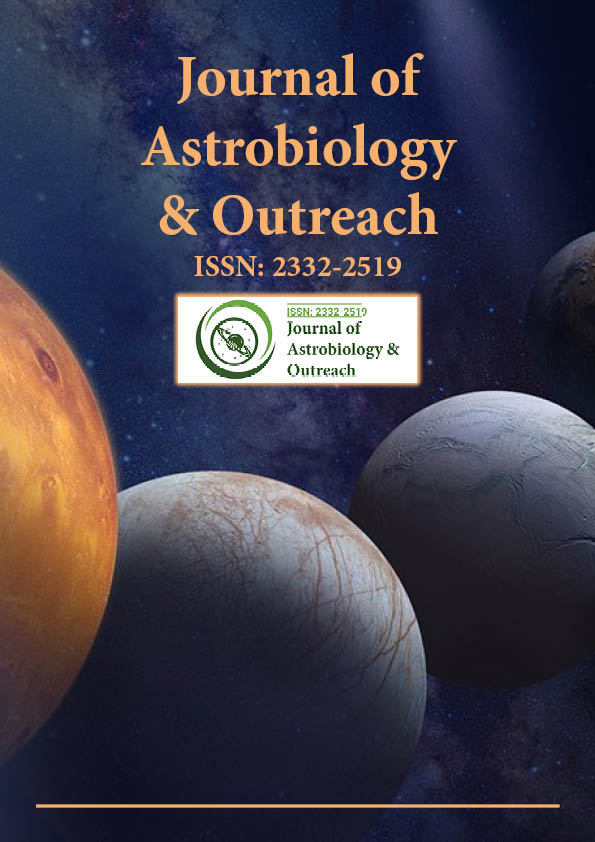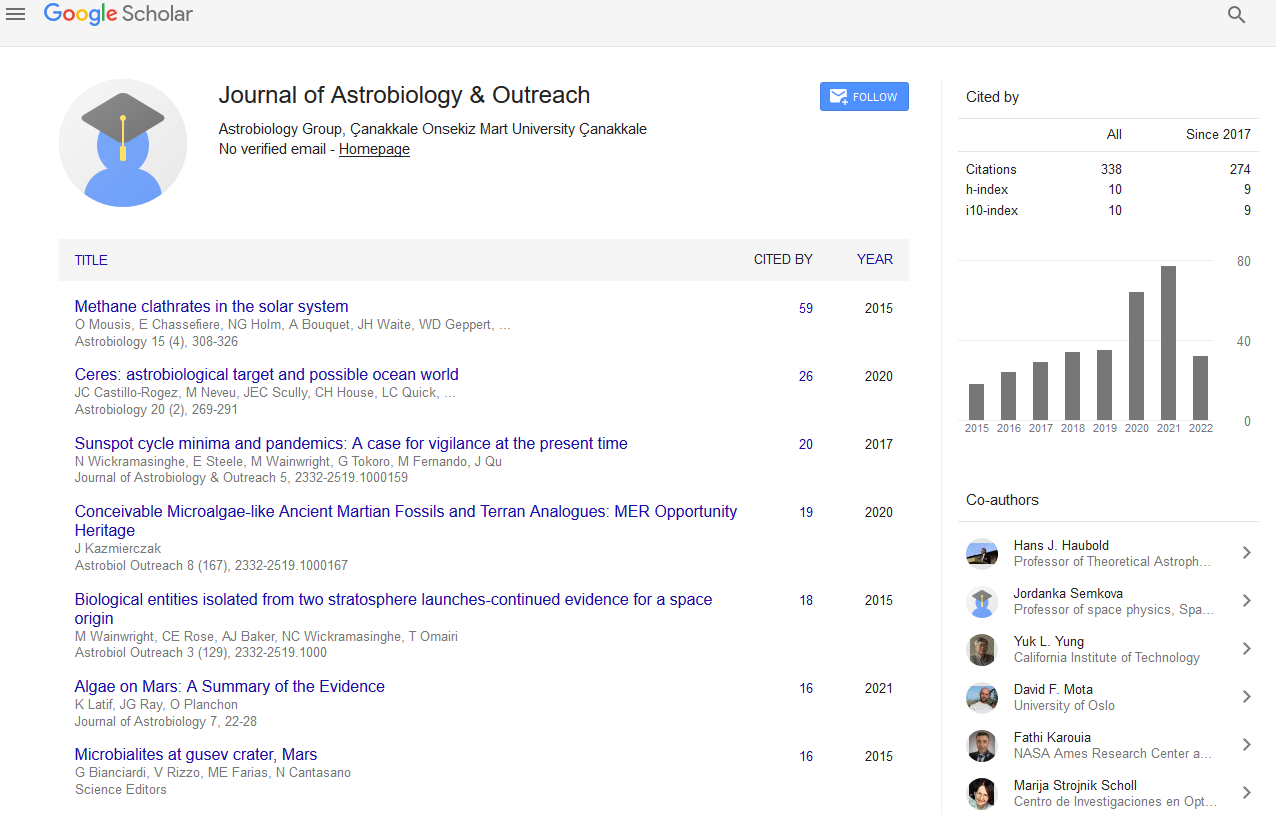Indexed In
- Open J Gate
- Academic Keys
- JournalTOCs
- RefSeek
- Hamdard University
- EBSCO A-Z
- OCLC- WorldCat
- Google Scholar
Useful Links
Share This Page
Journal Flyer

Open Access Journals
- Agri and Aquaculture
- Biochemistry
- Bioinformatics & Systems Biology
- Business & Management
- Chemistry
- Clinical Sciences
- Engineering
- Food & Nutrition
- General Science
- Genetics & Molecular Biology
- Immunology & Microbiology
- Medical Sciences
- Neuroscience & Psychology
- Nursing & Health Care
- Pharmaceutical Sciences
Commentary - (2024) Volume 12, Issue 4
Parietin Degradation and its Potential Applications in Astrobiology and Biotechnology
Miguel Oliveira*Received: 29-Nov-2024, Manuscript No. JAO-24-28007; Editor assigned: 02-Dec-2024, Pre QC No. JAO-24-28007 (PQ); Reviewed: 16-Dec-2024, QC No. JAO-24-28007; Revised: 23-Dec-2024, Manuscript No. JAO-24-28007 (R); Published: 30-Dec-2024, DOI: 10.35248/2332-2519.24.12.361
Description
Lichens, symbiotic organisms comprised of fungi and algae or cyanobacteria, produce a wide range of secondary metabolites with ecological and physiological significance. Among these metabolites, parietin, a bright orange anthraquinone pigment, serves as a photoprotective compound that protects lichens from excessive Ultraviolet (UV) radiation. The study of its degradation under UV exposure provides insight into the complex chemical resilience and adaptability of lichens in extreme environments, particularly from an astrobiological viewpoint. The investigation into the UV photo-degradation of parietin through multi spectroscopic techniques highlights the complex dynamics of lichen metabolites and their relevance to understanding survival strategies in extraterrestrial settings.
UV radiation, a prominent stressor in space and high-altitude terrestrial environments, can severely damage cellular structures and biomolecules. Lichens, with their remarkable ability to prosper in extreme habitats, depend on secondary substances like parietin for protection against UV-induced oxidative stress. The recent research utilizing multi-spectroscopic approaches to describe the photo-degradation pathways of parietin reveals its structural transformation under prolonged UV exposure. Such analyses provide valuable insights into how this pigment, serving as a protective barrier, undergoes photochemical reactions that may yield degradation products with varied properties. These findings have implications for the dual role of parietin as both a protector and a precursor to new bioactive compounds, a phenomenon that might be critical for lichen resilience.
From an astrobiological perspective, the study of parietin’s stability and degradation under UV radiation extends beyond terrestrial ecosystems. It serves as a proxy for understanding how biological molecules might behave in extraterrestrial conditions, such as the Martian surface or other planets with high UV flux. The structural changes identified in parietin during photo degradation could replicate the chemical evolution of biomolecules in space, providing clues to the mechanisms of molecular survival or transformation in extreme environments. The multi-spectroscopic analysis, which combines techniques like UV-vis spectroscopy, mass spectrometry and fluorescence spectroscopy, enables a detailed characterization of these transformations, emphasizing the resilience and adaptability of biological molecules.
The implications of this research are numerous. First, it highlights the utility of lichen secondary metabolites as models for studying photochemical resilience. The presence of parietinlike compounds on extraterrestrial terrains could signify potential biosignatures or markers of past life. Second, the degradation products of parietin, if bioactive, could play roles in adaptive processes, suggesting a dynamic chemical interaction between lichens and their environments. Finally, the methodological advancements demonstrated in this study create the path for future research into the photochemical properties of other secondary metabolites, broadening the scope of astrobiological investigations.
Another interesting dimension is the potential application of parietin and its degradation products in synthetic biology and bioengineering. By replicating the photoprotective and reactive properties of parietin, it might be possible to design novel materials or compounds for UV protection in space exploration technologies. Such biomimetic strategies could combine the chemical principles of natural resilience into advanced materials capable of withstanding risky extraterrestrial conditions.
Additionally, the degradation pathways of parietin provide a biochemical narrative on how lichens maintain their functional coherence. The balance between protective roles and degradation-induced transformations highlights the adaptive flexibility of lichens. This adaptability could inspire biotechnological applications where dynamic chemical responses are required, such as in sensors or responsive materials engineered for fluctuating environmental conditions.
In conclusion, the UV photo-degradation of parietin explored through multi-spectroscopic analysis contributes to our understanding of the biochemical resilience of lichens in extreme environments. This research connects terrestrial ecological chemistry with astrobiology, providing insights into molecular survival strategies under high UV flux. As we continue to describe the frontiers of life in extreme habitats, studies like this expand our knowledge of the complex exchange between biological molecules and environmental stressors, with significant implications for both Earth-based ecology and the search for life beyond our planet.
Citation: Oliveira M (2024). Parietin Degradation and its Potential Applications in Astrobiology and Biotechnology. J Astrobiol Outreach. 12:361.
Copyright: © 2024 Oliveira M. This is an open-access article distributed under the terms of the Creative Commons Attribution License, which permits unrestricted use, distribution, and reproduction in any medium, provided the original author and source are credited.

